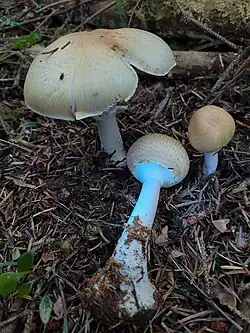Agaricus smithianus
| Agaricus smithianus | |
|---|---|

| |
| Scientific classification | |
| Kingdom: | Fungi |
| Division: | Basidiomycota |
| Class: | Agaricomycetes |
| Order: | Agaricales |
| Family: | Agaricaceae |
| Genus: | Agaricus |
| Species: | A. smithianus
|
| Binomial name | |
| Agaricus smithianus Kerrigan & L.A. Parra
| |
| Synonyms | |
|
Agaricus smithii Kerrigan | |
| Agaricus smithianus | |
|---|---|
| Gills on hymenium | |
| Cap is ovate or flat | |
| Hymenium is free | |
| Stipe has a ring | |
| Spore print is brown | |
| Edibility is edible | |
Agaricus smithianus, commonly known as the golden spruce agaricus[1] is a species of mushroom in the family Agaricaceae. It was first described in 1985 by Kerrigan as Agaricus smithii.[2]
Description
The cap of Agaricus smithianus is about 5–20 centimeters and starts out ovate before becoming convex or flat. It is golden or brown in color, with a darker disc in the center.[1] The stipe is about 5–12 tall and 2–3 centimeters wide, has a ring,[3] and is bulbous at the base. The gills are free, and start out pale, before becoming a pinkish tan color, and finally turning brown. After they turn brown, the gills darken with age. This mushroom is also reported to have an almond-like odor.[1]
Similar species
Agaricus augustus is similar in appearance, and also has an almond-like odor, but its stipe is less bulbous and the cap is scalier.[4]
Habitat and ecology
Agaricus smithianus is found under Sitka spruce[4] in conifer forests.[1] It is found in California[3] and occasionally near the coast in the Pacific Northwest.[1]
References
- ^ a b c d e Siegel, Noah; Schwartz, Christian (September 1, 2024). Mushrooms of Cascadia: A Comprehensive Guide to Fungi of the Pacific Northwest. Humboldt County, California: Backcountry Press. p. 81. ISBN 9781941624197.
- ^ "Species Fungorum - Species synonymy". www.speciesfungorum.org. Retrieved 2025-07-16.
- ^ a b Stevens, Michael Wood & Fred. "California Fungi: Agaricus smithianus". www.mykoweb.com. Retrieved 2025-07-16.
- ^ a b "Agaricus augustus – Mushrooms Up! Edible and Poisonous Species of Coastal BC and the Pacific Northwest". explore.beatymuseum.ubc.ca. Retrieved 2025-07-16.